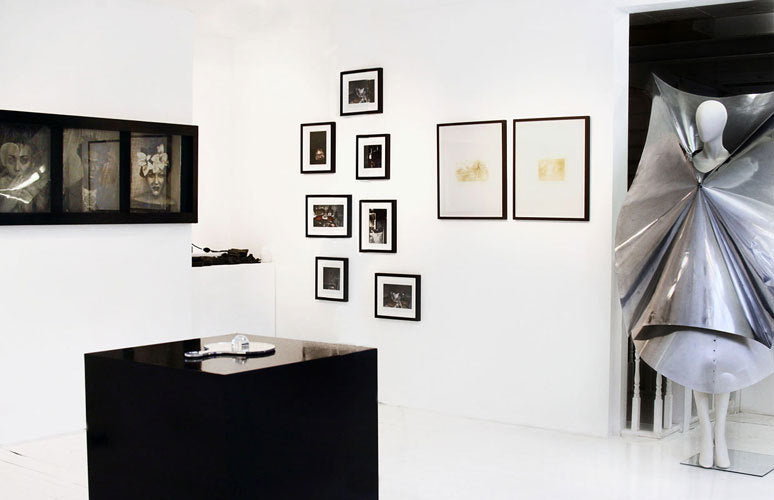
SHOWstudio's Practice to Deceive: Smoke & Mirrors in Fashion, Fine Art and Film, exhibition, was conceptually built around the expression “smoke & mirrors”, Practice to Deceive approaches the saying both literally - juxtaposing iconic photographs of people smoking and physical mirrored sculptural surfaces; and figuratively - looking at the expression and how it refers to deceit and artifice, two things that come up time and time again in art and fashion on many levels. Fundamentally, exhibition curators Nick Knight and Carrie Scott set out to both examine the artifice and illusion of the end product - from the artificiality of the historically 'fashioned' body, distorted with corsets and crinolines, to the wonders of modern retouching - as well as how smoke and mirrors are themselves infinitely seductive subjects; a pop-culture cliche of post-coital cigarette in mirrored boudoir and the implicit narcissism of a gaze into a mirror.
The exhibition included major works by Francois and Bernard Baschet, William Claxton, Jenifer Corker, Oleg Dou, Brian Dowling, TR Er-icsson, Fernand Fonssagrives, Dan Graham, Ruth Hogben, Walter Hugo, Stephen Jones, William Klein, Henry Krokatsis, Nick Knight, Craig McDean, Edward Quinn, Joseph Szabo, and Sissel To-laas. Also, as part of the exhibition, SHOWstudio.com invited key artists and major fashion designers to 'take up residence' in our LiveStudio in Bruton Place and create one-off garments and art pieces that were then added to the show.
In Francois and Bernard Baschet, Dan Graham and Henry Krokatsis' mirrored sculptures we vacillate between looking into our own reflection and looking at the material surface of the work. Where Graham’s highly polished recreation of a small girl’s make-up mirror seduces the viewer only to then distort, Krokatsis creates complex compositions that push the reflection into the backdrop so that subtle material differences in the mirrors’ surfaces come to the fore.
T.R. Ericsson nicotine drawings similarly play with our perception of image and material. To create his nostalgic works on paper, Ericsson used a silkscreen process whereby digital photographs are rendered in nicotine as ashtrays filled with up to six hundred smouldering cigarettes were placed beneath the screens, slowly creating pictorial stains. The faint smell of nicotine in each piece compliments the ghostly nature of Ericsson's images that are themselves an ode to his late mother, herself a serious smoker. Brian Dowling’s series, Fire, equally honours his mother. Painstakingly documenting the damage from a house fire at his mother’s flat, Dowling’s photographs emerge from darkened corners to reveal life and beauty in sheer destruction.
Jenifer Corker’s screens also take up fire as their primary subject. As reference to a long forgotten tradition, Corker embroidered hand-held fire screens, whose function was to protect ladies' complexions from the blush of the fire or the gaze of a stranger while they gossiped about the latest scandals of court. As a means both to conceal the truth and resist the voyeur, the adorned shields are literal and figurative smoke screens. Equally, scent artist Sissel Tolaas explores the binary expression, creating a wearable perfume created from coal extracted from the deepest mine in the North Pole. Tolaas' perfume evoked a strange sense of deceit: the bottled Essence Absolue of fired carbon opposes our expectation of a floral fragrance, drawing allusions to the olfactory alchemy of Jean-Baptiste Grenouille, antihero of Patrick Suskind's Perfume.
And yet, as it still surrounds both industries, the smell of smoke in fashion and fine art shouldn’t surprise us. As is laid bare in the collection of iconic fashion photography and fashion film throughout the show, the enduringly, if controversially, seductive quality of smoke appears in fashion photography and fashion film time and time again. From Joseph Szabo’s famed portrait of an unknown girl, a smoke casually dangling from her lips, to William Claxton’s snapshot of Steve McQueen seductively inhaling a cigarette, to Joe Calderone’s evocative performance in front of the lens - screened exactly where it was shot in-house for Japanese Vogue Hommes - the erotic connotations of smoke as a literal prop endures.
With these well known photographs we also positioned Walter Hugo’s ever-growing project in which the artist celebrated his peers from the world of art, fashion, film and music. Resurrecting long forgotten 19th century studio techniques to invigorate the traditional portrait with unpredictable results, Hugo painstakingly constructed unique portraits on glass plates. Given the sheer length of time the sitter must remain still for the exposure, the portrait of London today is an actual reflection on this moment in time as the subjects themselves steady themselves in front of his mirroring lenses.
Practice to Deceive is an obsessive journey around the flash-and-dazzle that has so preoccupied the worlds of fashion, fine art and film throughout their existence. But rather than dispel the myths, it sought to expose and explore the wonder of these workings for all to see. In essence, Practice To Deceive turns a mirror to the smoke and mirrors of contemporary culture.